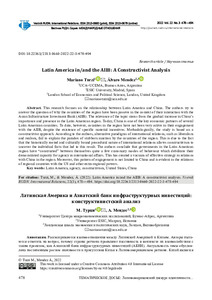Por favor, use este identificador para citar o enlazar este ítem:
https://repositorio.uca.edu.ar/handle/123456789/15194| Campo DC | Valor | Lengua/Idioma |
|---|---|---|
| dc.contributor.author | Turzi, Mariano | es |
| dc.contributor.author | Méndez, Álvaro | es |
| dc.date.accessioned | 2022-10-12T12:46:31Z | - |
| dc.date.available | 2022-10-12T12:46:31Z | - |
| dc.date.issued | 2022 | - |
| dc.identifier.citation | Turzi, M., Méndez, A. Latin America in/and the AIIB: A constructivist Analysis [en línea]. Vestnik RUDN. International Relations. 2022, 22(3) doi:10.22363/2313-0660-2022-22-3-478-494 | es |
| dc.identifier.issn | 2313‐0660 (print) | - |
| dc.identifier.issn | 2313‐0679 (online) | - |
| dc.identifier.uri | https://repositorio.uca.edu.ar/handle/123456789/15194 | - |
| dc.description.abstract | Abstract. This research focuses on the relationship between Latin America and China. The authors try to answer the question of why the countries of the region have been passive in the context of their interaction with the Asian Infrastructure Investment Bank (AIIB). The relevance of the topic stems from the gradual increase in China’s importance and presence in the Latin American region. Today, China is one of the key economic partners of several Latin American countries. To date, however, countries in the region have not been very active in their engagement with the AIIB, despite the existence of specific material incentives. Methodologically, the study is based on a constructivist approach. According to the authors, alternative paradigms of international relations, such as liberalism and realism, fail to explain the paradox of stubborn inaction by the countries of the region. This is due to the fact that the historically rooted and culturally bound procedural nature of international relations allows constructivism to uncover the individual facts that led to this result. The authors conclude that governments in the Latin American region have “constructed” between themselves quite a few customary modes of behaviour which debilitate their demonstrated capacity for agency in international affairs. This has created a vacuum of effective strategy in relations with China in the region. Moreover, this pattern of engagement is not limited to China and is evident in the relations of regional countries with the US and other extra-regional powers. | es |
| dc.format | application/pdf | es |
| dc.language.iso | eng | es |
| dc.publisher | RUDN University | es |
| dc.rights | Atribución-NoComercial-CompartirIgual 4.0 Internacional | * |
| dc.rights.uri | http://creativecommons.org/licenses/by-nc-sa/4.0/ | * |
| dc.source | Vestnik RUDN. International Relations. 2022, 22(3) | es |
| dc.subject | AMERICA LATINA | es |
| dc.subject | China | es |
| dc.subject | RELACIONES INTERNACIONALES | es |
| dc.subject | CONSTRUCTIVISMO | es |
| dc.title | Latin America in/and the AIIB: A constructivist Analysis | es |
| dc.type | Artículo | es |
| dc.identifier.doi | 10.22363/2313-0660-2022-22-3-478-494 | - |
| uca.disciplina | CIENCIAS SOCIALES | es |
| uca.issnrd | 1 | es |
| uca.affiliation | Fil: Turzi, Mariano. Pontificia Universidad Católica Argentina. Facultad de Ciencias Económicas. Departamento de Investigación Francisco Valsecchi; Argentina | es |
| uca.affiliation | Fil: Turzi, Mariano. Universidad del CEMA; Argentina | es |
| uca.affiliation | Fil: Méndez, Álvaro. London School of Economics and Political Science; Inglaterra | es |
| uca.affiliation | Fil: Méndez, Álvaro. ESIC University Madrid; España | es |
| uca.version | publishedVersion | es |
| item.languageiso639-1 | en | - |
| item.fulltext | With Fulltext | - |
| item.grantfulltext | open | - |
| crisitem.author.dept | Facultad de Ciencias Económicas | - |
| crisitem.author.dept | Departamento de Investigación | - |
| crisitem.author.dept | Centro Indo-Pacífico | - |
| crisitem.author.orcid | 0000-0002-4370-6412 | - |
| crisitem.author.orcid | 0000-0002-0919-5081 | - |
| crisitem.author.parentorg | Pontificia Universidad Católica Argentina | - |
| crisitem.author.parentorg | Facultad de Ciencias Económicas | - |
| crisitem.author.parentorg | Departamento de Investigación | - |
| Aparece en las colecciones: | Artículos | |
Ficheros en este ítem:
| Fichero | Descripción | Tamaño | Formato | |
|---|---|---|---|---|
| latin-america-AIIB.pdf | 552,29 kB | Adobe PDF |  Visualizar/Abrir |
Visualizaciones de página(s)
125
comprobado en 27-abr-2024
Descarga(s)
105
comprobado en 27-abr-2024
Google ScholarTM
Ver en Google Scholar
Altmetric
Altmetric
Este ítem está sujeto a una Licencia Creative Commons

